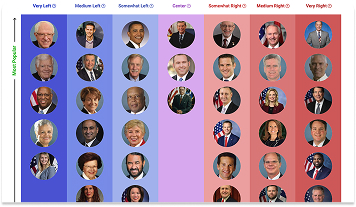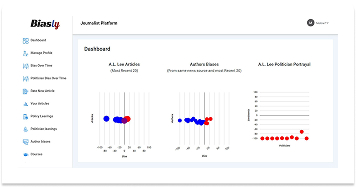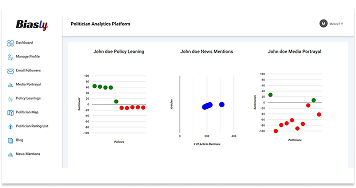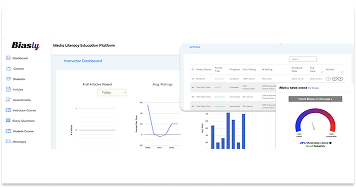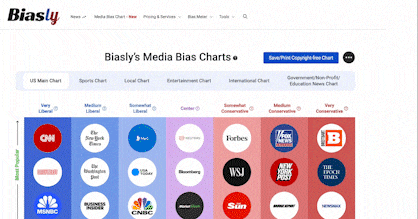Bias Meter
Extremely
Liberal
Very
Liberal
Somewhat Liberal
Center
Somewhat Conservative
Very
Conservative
Extremely
Conservative
-100%
Liberal
100%
Conservative

Biasly determines media bias ratings through a dual-layered approach combining artificial intelligence and analyst review. The platform’s proprietary bias detection engine, Bias Meter, evaluates sentiment, policy position alignment, and language framing across thousands of data points in news articles. Analysts then verify and interpret the AI’s findings, providing additional context where needed. Learn more
- Profile
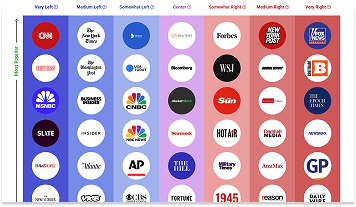
NY Times on the media bias chart
NY Times has a Bias Score of -28% Somewhat Left which is based on a variety of factors including its policy and politician leanings, article ratings, and the use of biased language. Its Reliability is rated as Average, and additional analytical insights are available in the other tabs.
- Bias Rating
-28% Somewhat Left
- ReliabilityPolicy Leanings
-2% Center
Extremely
LiberalVery
LiberalModerately
LiberalSomewhat Liberal
Center
Somewhat Conservative
Moderately
ConservativeVery
ConservativeExtremely
Conservative-100%
Liberal100%
Conservative
Average Reliability
*Our bias meter rating uses data science including sentiment analysis, machine learning and our proprietary algorithm for determining biases in news articles. Bias scores are on a scale of -100% to 100% with higher negative scores being more liberal and higher positive scores being more conservative and 0% being neutral. The rating is an independent analysis and is not affiliated nor sponsored by the news source or any other organization.
Politician Portrayal94% negative
Continue For Free
Create your free account to see the in-depth bias analytics and more.
By creating an account, you agree to our Terms and Privacy Policy, and subscribe to email updates.
Policy Leanings Analysis
Policy | Bias score |
|---|
NY Times Editorial Patterns
While some coverage leans Somewhat Left, NY Times generally exhibits politically moderate patterns in phrasing, source selection, and thematic focus. The publication demonstrates journalistic standards in many of its reports, although the choice of issues, framing, and word usage can occasionally indicate a politically left-leaning slant from issue to issue. This content analysis examines how The Times handles liberal and conservative issues and evaluates its language choices and editorial tendencies.
Coverage of Liberal vs. Conservative Topics
NY Times puts out news on a large swath of topics. Its speciality, though, is politics, especially in America. The Times covers political issues and politicians across the ideological spectrum, offering fairly well-balanced coverage of news concerning both Democrats and Republicans. However, the two sides are not always presented equally.
Like many outlets, The Times’ coverage of politicians typically reads critically. However, they have a pattern of presenting liberal figures in a better light than conservative ones.
The Times demonstrates this through its reporting on Senator Bernie Sanders and Representative Alexandria Ocasio-Cortez. News around Sanders characterizes him as resilient (“Bernie Sanders Isn’t Giving Up His Fight”), passionate, and popular. The Times often paints Ocasio-Cortez as the future of the party, a beacon of hope for Democrats. In one article, her approach to politics is praised as being “contemporary,” “politically-skilled,” relatable, and powerful. Another article discussing the next generation of Democratic leaders puts it succinctly:
“She is what’s next — if she wants it.”
A piece on Sanders’s and Ocasio-Cortez’s joint rally tour exemplifies The Times’s positive coverage of Democrats. In it, journalist Kellen Browning writes that the two are “electrify[ing] Democrats” and “energizing” the party. Browning states,
“The two progressives are providing the kindling, offering the party’s beaten-down base the fighting spirit it has been missing.”
Browning also emphasizes the large turnout at the rallies and the excitement of members in the crowd. All of these elements come together to create an uplifting, optimistic view of Sanders, Ocasio-Cortez, and the Democratic Party as a whole.
Both politicians have been interviewed multiple times by The Times. They also have written opinion pieces for the publication (in Sanders’ case, many times), and articles about them often directly quote them. All-in-all, they often receive ideal characterizations, or at least fair representations.
Popular Republicans don’t often receive positive framing. The Times’s coverage of members of the Republican Party, particularly those in President Donald Trump’s Administration, largely trends negative. This pattern holds with a few exceptions. Both Secretary of State Marco Rubio and Director of National Intelligence Tulsi Gabbard have consistently been the subjects of bad press.
In the article “Rubio’s Cuts at State Department Demote Longtime U.S. Values,” author Michael Crowley showcases biting criticism towards Rubio’s reorganization plan. Rubio is set up as a threat to American stability and its power abroad. He is portrayed as sacrificing human rights to align himself with “Mr. Trump’s narrow and transactional sense of the national interest.”
Reporting on Gabbard often emphasizes her lack of experience with government intelligence. She has also been referred to as “a darling of the Kremlin” and “conspiratorial.” One article on her foreign policy stances in Russia went so far as to say:
“She has embraced a worldview that mirrors disinformation straight out of the Kremlin’s playbook.”’
These examples of partisan framing and biased reporting are important to keep in mind. When we are aware of these patterns, we can be more proactive about stopping biased news from drastically changing our perspectives. The Times shows its hand as a Somewhat Left-leaning publication in its coverage of politicians from different political backgrounds. Luckily, it demonstrates a bit more restraint and balance in its coverage of various policy issues.
Policy and Issue Framing
The way that NY Times frames policy issues lends some more credibility to the publication. Though it takes a more liberal policy stance on some issues, it balances coverage by taking a neutral perspective on several others.
An area where The Times leans more left is on the topic of education. These articles often justify affirmative action policies and criticize defunding higher education. In “How Trump’s War on Higher Education Is Hitting Community Colleges,” bias is recognizable from the headline. Portraying Trump’s limiting federal funding to colleges as waging a war is an obvious editorialization. Additionally, the headline immediately indicates its negative view of Trump’s policies by highlighting a negative consequence. The rest of the article explores all the ways Trump’s outlook on higher education may fail students who attend community college.
The Times also takes a slightly more Democratic stance on immigration and ICE, though they have neutral coverage as well. Elisabeth Bumiller’s piece on deportations in California’s Central Valley invokes a sense of panic and trepidation. Bumiller describes the region as “on edge,” “in a rage,” and fueled by fear as a result of ICE raids. She also addresses economic concerns about raids disrupting the agricultural sector of California, since many laborers are undocumented. The article reads,
“[The business of California agriculture] is also one that President Trump has thrown into turmoil. Only in recent weeks has he offered vague glimmers of hope.”
The tone of this piece is negative. By using emotionally charged language and focusing on the psychological and economic impacts of a raid, this article reflects a more liberal perspective on deportations.
On the other hand, The Times has published some very moderate and straightforward articles on immigration. In pieces on a State Department immigration program and deportation litigation, the journalists address the topics from objective standpoints. These articles stick to direct quotes, government statistics, and foundational facts, using impartial language to remain strictly informative rather than subtly persuasive.
An issue that The Times tends to remain neutral on is business and international finance. Even pieces that revolve around policies coming from Trump in this area are balanced and fair. One article on Trump’s plan to sell government shares of a company under federal control demonstrates this unbiased approach. This piece positions the plan in an adequate economic and historical context, and gives both the pros and cons of the plan their due diligence.
The Times reported on issues with economic policies in a nonpartisan way, too. Lydia DePillis raised a logistical concern with Trump’s tariffs. But, instead of framing it as an attack on the credibility of the Administration, she simply explored and explained the problem. DePillis phrased her central question:
“As President Trump’s worldwide tariffs go into effect, one important element remains fuzzy: How will the government treat goods and materials that pass through more than one country before arriving in the United States?”
Without ideological preference, this article from The Times identifies a complication logically. In doing so, it depicts its grasp on producing and publishing unbiased work.
Coverage and Relevance
NY Times is an immense influence on journalism around the world. Their reporting contributes to wider discourse about the impact of political bias on the audience and the media industry. The Times’s wide reach and expansive reporting on all manner of political issues make it a perfect place to explore the importance of tone, coverage, and framing. Therefore, the instances where The Times breaks from nonpartisan reporting and the times where it prioritizes this approach both give us insight into how biased media is constructed and received. When we look at how The Times reports and colors the news, we learn about what both biased and unbiased journalism looks like.
If you want to take a closer look at how NY Times covers and frames the news, check out Biasly’s Media Bias Chart to get a sense of how it compares to other news outlets.
NY Times Bias Analysis
NY Times is one of America’s longest-running news publications. The outlet was founded in 1851. As such a well-established publication, The Times has a storied history decorated with various accolades and contributions to journalism as a whole. The Times won its first Pulitzer Prize in 1918 and has won 144 more since. This is more than any other organization. It has won more than 100 miscellaneous awards in journalism, including an Academy Award.
NY Times has been reporting on the front lines during critical turning points in American history for decades. Journalists from this publication are credited with exposing the infamous political corruption by “Boss” Tweed in the late 1800s. Other noteworthy high points in The Times’s history are their breakthrough reports on the Manhattan Project and the #MeToo movement. Famously, The Times was also the first to break the story of the leaked Pentagon Papers that shed light on the reality of the Vietnam War.
Additionally, a landmark Supreme Court case, New York Times v. Sullivan, marks a key moment for The Times. In this case, the Supreme Court ruled in favor of The Times. Ultimately, this made it much more difficult for all news publications in America to be sued for defamation or libel.
The Times professes to abide by the core values of ethical journalism. Their practice revolves around their faith in the social, political, and economic power of reporting. Here is their mission statement:
“We seek the truth and help people understand the world. This mission is rooted in our belief that great journalism has the power to make each reader’s life richer and more fulfilling, and all of society stronger and more just.”
Topics that The Times covers span across various diverse topics. Their outlet reports on politics, world events, business, sports, travel, entertainment, self-help, product reviews, and more. They also have a slew of podcasts, games, and recipes. The Times truly is a journalistic giant.
For this reason, The Times is still one of the most well-known publications. The Pew Research Center found that 84% of all U.S. adults have heard of The Times.

Source: Pew Research Center
As of August 2025, The Times has more than 11 million subscribers. Most of these subscribers are digital, though around 600 thousand are subscribed to the print edition. They are expecting their subscriber count and revenue numbers to continue growing steadily.
So, we’ve established that NY Times is prolific and popular. But the question remains: are they credible?” Let’s dive into The Times’s editorial patterns to determine how big an issue media bias is in their reporting.
Is NY Times Biased?
Based on Biasly’s evaluations, NY Times is rated as Somewhat Left.
By examining content patterns and the broader context of media influence, we aim to offer a balanced perspective on The Times’s political bias—and contribute to the ongoing discussion about bias in the news.
How Does Biasly Rate News Sources?
Biasly uses proprietary algorithms and a team of analysts to provide comprehensive bias evaluations across thousands of news outlets. Over 200,000 articles from more than 3,200 sources have been analyzed to identify the most accurate and unbiased stories.
Biasly assigns each outlet three key scores:
- Reliability Score – Reflects factual accuracy
- AI Bias Score – Generated via natural language processing
- Analyst Bias Score – Assessed by human political analysts
These scores are based on seven core metrics: Tone, Tendency, Diction, Author Check, Selection/Omission, Expediency Bias, and Accuracy. These elements help analysts and algorithms evaluate the political attitude conveyed by each article.
Biasly’s Bias Meter ranges from -100% (most left) to +100% (most right), with 0% indicating neutrality. The system evaluates individual articles based on political terms, policies, figures, and sentiment to calculate precise bias ratings.
Is NY Times Politically Biased?
NY Times earns Somewhat Left score rating for its AI Bias Score and Somewhat Left for its Analyst Bias Score. The paper maintained objectivity on topics like foreign policy and global economics. However, we have noted liberal preferences in areas like coverage of Democratic politicians and policy topics such as abortion and environmental issues.
The kind of topic that an article covers may affect whether The Times comes off as more biased or more neutral. The Times generally does its best to minimize this trend. When it comes to policy issue portrayal specifically, The Times often balances its coverage across articles, if not within each article itself. On the contrary, the variation in portrayals of politicians across the spectrum and their occasional (but not rare) favorability towards the left indicates bias. The Times is a well-established news titan with domestic and international recognition. As such a large organization, it’s not surprising that bias will show up in some of its reporting. This does not mean that we should not continue holding these outlets accountable. What it does mean is that we need to read news from publications like The Times carefully. Recognizing our personal biases and the political biases in media outlets is a good place to start.
That is why we assign outlets a bias score. This bias score is determined through natural language processing that evaluates the tone, word choice, and opinion embedded in the reporting. Recent AI evaluations highlight left-leaning, fairly negative coverage of Trump and his administration, and more moderate reporting on domestic and global taxes.
Analysis of Bias in NY Times Online Articles
NY Times has a hefty handbook on ethical journalism, outlining standards they expect their journalists to abide by. Some of these standards include accuracy, independence, and impartiality. The Times asserts that they pursue journalism “without fear or favor.”
So, has The Times abided by its standards of ethical journalism? Or have they slipped into practices of biased reporting? Is The Times a perpetrator of bias in the media?
To explore this question, let’s dive into examples of articles from The Times. To examine this topic, we use 5 criteria to determine bias at Biasly: Tone, Tendency, Author, Diction, and Expediency Bias. Here’s how we define each of these categories:
- Tone: Reflects the journalist’s overall perspective on the subject
- Diction: The journalist’s unique selection of words
- Author: The journalist’s own views
- Tendency: Patterns and trends throughout a journalist’s career
- Expediency Bias: Visual and text cues in an article that signal media bias or a lack of credibility
Let’s dive into some of The Times’ better work in factual reporting with an article from Maggie Haberman, Steven Erlanger, and Andrew E. Kramer. These three journalists wrote an article on the announcement that Trump will meet with Russian President Vladimir Putin and Ukrainian President Volodymyr Zelensky. As many pieces on foreign policy from The Times are, this article is straight-shooting and moderate in tone.

Source: NY Times
The first impression of this article is good. The headline itself uses very moderate language; there are no emotional or controversial words or phrases. It also avoids clickbait by being clear about what the article is going to entail. Additionally, the title and the byline indicate that the article is going to draw information from a primary source, Trump himself. This already gives the piece some credibility. The journalists also selected a neutral image to accompany the headline. The image does not imply a preference in diplomatic stance or nationalist sympathies. It simply displays Trump and Putin meeting in the past, which is exactly what the two say they will do in the future.
The rest of the article is just as objective as its initial features. The main point of the piece is in the first few sentences, followed by relevant background. Haberman, Erlanger, and Kramer underscore statements made directly by officials involved and contextual information. Occasionally, the journalists will provide further explanation or commentary when it makes sense. They steer clear of overwrought worries or speculation.
There are one or two blips in the article that betray some skepticism towards Trump’s negotiation abilities. For example, the journalists recount a previous instance where Trump tried to deploy his diplomacy skills with North Korean Supreme Leader Kim Jong-Un. They write:
“Mr. Trump was convinced that he could talk Mr. Kim out of his nuclear weapons by promising to lift long-running sanctions. The meetings were cordial and an utter failure […] Mr. Kim now has a larger [nuclear weapon] arsenal than ever.”
Saying that Trump was “convinced” by his own strengths makes him seem a little bit narcissistic or naive. Describing the meetings as an “utter failure” comes off somewhat dramatic, though they provide an understandable reason for doing so.
Though this moment may suggest a broader pessimism towards Trump’s diplomacy, this is as severe as it gets. If the article is biased, it is only ever-so-slightly left-leaning. Overall, Haberman, Erlanger, and Haberman wrote an informative, moderate piece. Foreign wars and the Trump Administration can both be highly polarizing. This article is exemplary of good factual reporting and mostly unbiased work from The Times.
Nonetheless, The Times publishes plenty of articles with more identifiable bias. Though often not too egregious, there is a light left-leaning trend in their factual reporting. One example of this issue is in Hiroko Tabuchi’s article, “The ‘Alligator Alcatraz’ Site Once Changed History. Now, It’s Testing the Law Again.” In this piece, Tabuchi examines environmental controversy around the ‘Alligator Alcatraz’ site in the past and present.
Tabuchi also takes great care to situate the controversy in a historical and legal context. However, though she reports on both pro- and anti-Alligator Alcatraz stances, she emphasizes the latter group much more heavily. Tabuchi does not evenly analyze the parties to the situation. Instead, much of the article relays potential environmental and climate consequences as a result of the facility.
Additionally, the way that the article is set up seems to favor environmentalist arguments (who usually align with leftist ideals). When Tabuchi does offer a perspective from supporters of Alligator Alcatraz, she immediately follows it up with a rebuttal from the environmentalists. This structure makes it seem like Tabuchi is attempting to “debunk” those arguments, rather than neutrally provide alternative perspectives. The difference may seem subtle, but it is still highly impactful.
Tabuchi also uses strong language to describe the Trump Administration’s actions. The article notes,
“This year, President Trump took an unusually aggressive step to weaken that law, the National Environmental Policy Act, known as NEPA.”
And,
“The Department of Homeland Security has aggressively expanded its detention capacity.”
She also characterizes the “immigration crackdown” as “aggressive.” By repeatedly associating the Trump Administration’s immigration initiatives in Florida with aggression, Tabuchi demonstrates a negative bias towards the right-leaning stance on this issue. Her diction, in tandem with her unequal representations, skews the article as a whole to the left.
Tabuchi’s own biases may be bleeding into her work. Her general writing history implies a Somewhat Left-leaning bias, indicating that she may have more liberal views in her personal life. Moreover, though Tabuchi’s online presence is mostly professional, some of her comments seem to align with sentiments on the left. For example, she made a post on X, seemingly condemning conservative efforts to limit environmental restrictions. The article she attaches also reads left-leaning.
A Supreme Court case being decided this month is the product of a coordinated, multiyear strategy by Republican attorneys general and allies to rewrite environmental law and weaken the executive branch’s ability to tackle global warming. @CoralMDavenport https://t.co/xyPLL1QhUe
— Hiroko Tabuchi (@HirokoTabuchi) June 20, 2022
Tabuchi also made a post in support of gun control, asserting that “gun violence is very rare in Japan — because strict gun control laws work.” It is possible that Tabuchi, knowingly or unknowingly, let her own perspective color her reporting. In all fairness, this article is not too extreme in overtly pushing a political agenda.
Both of these articles are fairly reliable and not misinformative. The mostly unbiased (perhaps with a slight left lean) piece on U.S. diplomacy and the moderately to lightly biased article on Alligator Alcatraz provide an accurate sample of reporting from The Times. As a Somewhat Left publication, The Times has an editorial tendency that favors liberal views. But these biases are not extreme and do not often significantly damage its credibility.
Analysis of NY Times’s Opinion Articles
To fully understand how political bias operates in the news, we need to be aware of the differences between factual reporting and opinion pieces. Factual reporting presents concrete information and is supposed to be objective. In contrast, opinion articles express the author’s stances on pertinent issues. In the previous section, we walked through examples of factual reporting from NY Times. In this section, we’re going to examine how bias shows up in the coverage and tone of their opinion articles.
Jason Furman, a professor and former chair of the Council of Economic Advisers, wrote an opinion piece for The Times on the economy. His article, “The Tariffs Kicked In. The Sky Didn’t Fall. Were the Economists Wrong?” attempts to understand why Trump’s tariffs did not result in the catastrophe critics expected. In doing so, he explores multiple economic factors and angles that might have contributed to the outcomes. Furman uses simple and accessible comparisons to explain his inferences and claims to readers. This mirrors his overall straightforward and uncomplicated approach towards the topic. He uses statistics, numbers, and even a chart when necessary to support his ideas. Furman, recounting his initial thoughts on the tariffs, even succinctly concedes his shortcomings:
“Economists, including me, suffer from tariff derangement syndrome.”
Furman does an excellent job of telling the audience what he thinks and why, without telling the audience what to think. This kind of attitude towards journalism contributes to why Biasly gives writers like Furman a Center journalist rating.
Not every opinion article in The Times shares this strength. Journalist and author Michelle Goldberg took on a strong left-leaning perspective in her article “The MAGA Congressman Accused of Threatening His Ex With Revenge Porn.” In this piece, Goldberg does not obfuscate her feelings towards the Republican Party and MAGA movement with subtly emotionally-charged language. Goldberg doesn’t just paint them in a bad light; she outright condemns them.
After explaining the allegations against Representative Cory Mills, Goldberg extrapolates this scandal to the wider culture of the MAGA movement. She writes,
“Today, even if Mills did in fact threaten a young woman with revenge porn, he wouldn’t stand out amid the climate of swaggering impunity and macho vice-signaling that mark the second Trump term.”
The latter half of this article is filled with these bold accusations that antagonize the state of the Republican Party. Goldberg ends the article by asserting that,
“For now, though, Mills embodies America’s ruling ethos: When you’re MAGA, they let you do it.”
This framing tendency underscores the importance of recognizing when reporting is meant to be factual or an opinion piece. The opinion section of a news outlet is a small fraction of its content. Opinion articles alone don’t always accurately reflect a publication’s editorial patterns. As we’ve explained, NY Times is a generally left-of-center publication. This comes from looking at opinion articles, factual reporting, and overall reliability. We must take care to consider factors outside of opinion sections when analyzing a news publication’s political leanings, too.
Who Owns NY Times?
A.G. Sulzberger is the chairman of NY Times. Sulzberger took over in 2018. His family has stewarded The Times since 1896.

Source: A.G. Sulzberger, Publisher, NY Times after his talk as part of the Knight Media Forum. (Photography by Patrick Farrell)
The Times is a publicly traded company; it does not fall under the umbrella of a larger media conglomerate. Anyone can buy shares of the publication. This can be a good thing for steering away from bias in the news. Because it is public, The Times does not have to follow the journalistic preferences of a bigger company.
That doesn’t mean that no one has any influence over The Times. The Ochs and Sulzberger families have a lot of stake in the company and influence on the Board of Directors. Shareholders elect people to the Board of Directors to represent their financial interests. Who they elect can give us an idea of the investors’ priorities. For example, the Board of Directors for The Times has high-ranking representatives from Bumble, Roblox, GoDaddy, and Etsy. The people they represent may have some level of influence over The Times’s priorities.
Most of The Times’s revenue comes from subscriptions, sales from products they review in the Wirecutter section, and advertisements. They are not heavily propped up by outside donations, which is good for independence. As an organization, The Times itself did not donate to any political campaigns in the 2024 election cycle. But, it is worth noting that owners, employees, and/or their families contributed almost 250k in total to overwhelmingly Democratic campaigns. This may reflect the personal political stances of those who work at The Times. These personal biases could bleed into the outlet’s news.
How to Evaluate Bias
Although Biasly rates NY Times as Somewhat Left, it’s important to remember that bias can vary from article to article. The Times also covers a moderate slate with objectivity on many issues, like Black Lives Matter protests and affirmative action. This complexity underscores the importance of examining each article individually. So, let’s learn how to evaluate media bias.
Recognizing media bias requires awareness and critical thinking. Often, readers trust news sources that affirm their existing beliefs—a psychological tendency known as confirmation bias. This makes it harder to identify slanted narratives or one-sided reporting.
To combat this, it’s essential to challenge your assumptions by consulting multiple viewpoints and verifying news through third-party analysis. Tools like Biasly’s media bias ratings allow readers to compare the same news story across the political spectrum.
Ultimately, bias isn’t always a matter of what is said—it’s also about what is left out, how topics are framed, and which stories are chosen for coverage. Learning to recognize these patterns can help readers make more informed decisions and develop greater media literacy.
To start comparing news outlets and gain a better understanding of bias, sign up for Biasly’s Media Bias & News Analytics Platform to see how stories vary between sources.
NY Times Reliability Analysis
Is NY Times Reliable?
NY Times has a relatively high factual accuracy, but falls in the middle of the spectrum of reliability overall. While their concrete information is usually true, it is not always framed or sourced in a credible or neutral way.
Why might this be? Because The Times is such a huge presence in the journalism field, they have a much larger audience than many other publications. Therefore, they may have more of an incentive to produce biased content. Outlets like The Times must keep and grow an already sizable viewer base and likely maintain public-facing political and economic relationships.
This means that they may be more apt to appease their viewers by pushing content they want to see. A strategy like this does not always make for the most reliable journalism.
For The Times, their influence and popularity may be a factor in their Somewhat Left bias. The Pew Research Center reported that in 2025, almost 50% of U.S. Democrats and left-leaning voters who offered an opinion on The Times’s reliability found the outlet trustworthy. This is very different from the 19% of right-leaning voters/Republicans who offered an opinion on its reliability.
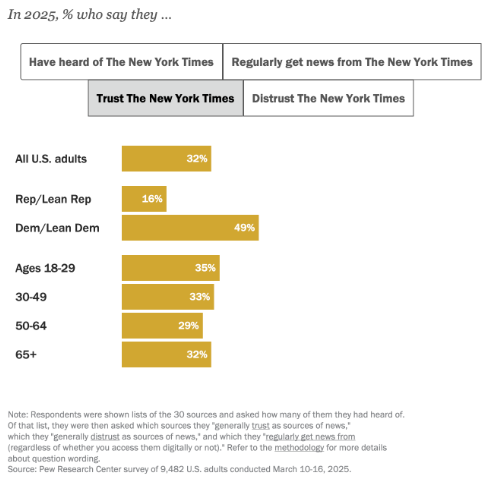
Source: Pew Research Center
Since The Times is more popular among left-leaning voters, it may be motivated to please this audience with left-leaning coverage.
Media bias and reliability go hand-in-hand. So, Biasly doesn’t just assess where outlets fall on the political spectrum, but also evaluates their reliability as well. Let’s take a look at the accuracy and credibility of The Times.
How to Evaluate Reliability?
Reliability refers to how trustworthy or accurate a news source is. If we can’t trust what we read, then continuing to consume content from that outlet serves little purpose. So how do we evaluate a news outlet’s reliability?
There are several potential measures of reliability to look out for when trying to determine whether a media source is reliable or not. Red flags for an unreliable article can include unsubstantiated claims, reliance on untrustworthy sources, and highly opinionated language. In contrast, hallmarks of a reliable source include:
- Absence of subjective language
- Citing credible sources (e.g., .gov, .edu, academic references)
- Verifiable facts and statistics from multiple outlets
- Use of primary sources, like interviews or transcripts
- Consistency with coverage across other platforms
Biasly’s reliability scores incorporate these elements in evaluating media outlets.
So How Does NY Times Fare in Its Reliability?
The political reliability index developed by Biasly assesses both accuracy and trustworthiness. NY Times currently holds Average Reliability Score, which is calculated as a weighted average of:
- Fact Analysis Score – Evaluates the accuracy of claims, facts, and evidence.
- Source Analysis Score – Assesses the number, diversity, and credibility of sources and quotes used.
The Times’s Source Analysis Score is rated Average. This suggests moderate trustworthiness in its sourcing practices. The score is AI-generated and considers quote length, frequency, diversity, and quality.
The Times’s Fact Analysis Score is rated Good. This score reflects a fairly high trustworthiness in how The Times supports its claims, addresses selection and omission bias, and presents verifiable evidence. In addition to the Fact Analysis Score, readers are encouraged to perform their own evaluations using Biasly’s media bias tools.
While NY Times tends to provide very factual reporting, occasional instances of political bias or misrepresentation can affect its reliability rating. This highlights the importance of analyzing individual articles.
NY Times’s Accuracy and Reliability
According to Biasly’s analysis, NY Times maintains Average Reliability Score, but individual articles may vary significantly. Let’s dive into the details.
The political orientation of reporting impacts the audience’s perception of the news in terms of its reliability. The Times is known for its Somewhat Left-leaning coverage. However, some may claim that there is much more or much less bias. To validate these arguments, it’s essential to analyze whether the publication backs its assertions with sufficient evidence and diverse viewpoints.
Two common types of bias that affect factuality include:
- Selection Bias – Selectively emphasizing certain stories and ignoring others to support a specific narrative
- Omission Bias – Leaving out alternative viewpoints or crucial details to impact the audience’s perspective.
Biasly’s accuracy ratings use a scale from 1% (least accurate) to 100% (most accurate). Factors include the presence of supporting evidence, internal and external reliable sources, and balanced viewpoints.
For instance, Biasly gave the Falls Church News-Press (FCNP) a bias rating of Medium Left and a Limited reliability score. These two factors are related, and news from the FCNP demonstrates this. For example, this article from journalist and owner Nicholas Benton is titled, “4,700 Wire Transfers? How Key Was Trump to Epstein?” Immediately, a bias is clear. The headline nudges readers to make a connection between President Donald Trump and known sex-trafficker Jeffrey Epstein. There are several things wrong with the body of the article. First, it only spends about 6 sentences on the topic of the headline, in a very conspiratorial tone. In those 6 sentences, Benton claims that Trump made 4,700 wire transfers to Epstein and thus may have been working with him. Benton provides no source or supporting evidence for this claim. A quick Google search reveals that this claim is verifiably false. The rest of the article, again with no sources, correlates this issue with themes of rising crime, the separation of church and state, holocaust denial, and the claim that Democrats are fundamentally better people:
“[Democrats] are more like what people are supposed to be like. They practice basic courtesy and manners, recognizing that they are virtues taught and applied to hold civilization together. But Trump and Trumpians don’t play by those rules at all. They are ruthless and deceitful in ways that ordinary nice people simply aren’t.”
Benton’s personal political bias has obscured a focus on abiding by journalistic standards. As a consequence, the FCNP ended up publishing an article with wild, unfounded (and hard-to-follow) claims and disseminated blatant misinformation. Because of this, the FCNP damages its credibility. The bias and reliability measures impact each other.
NY Times has moments where bias obstructs accuracy, but luckily, these instances are less severe and fewer in number. Let’s apply this kind of analysis to articles from The Times to further investigate the outlet’s reliability. Our breakdown will consider selection bias, omission bias, and the quality of the sources and facts this news outlet uses.
Analysis of Reliability in NY Times’s Online News Articles
NY Times has a staff that includes writers from varying political and ideological backgrounds, which can help balance coverage. Even so, readers should distinguish between objective news reporting and politically-charged opinion pieces to evaluate credibility most effectively.
An example that demonstrates The Times’s slightly left-biased but factual reporting is the article “How Trump Officials Debated Handling of the Abrego Garcia Case.” In this article, journalists Hamed Aleaziz and Alan Feuer report on the government’s mistaken deportation of Abrego Garcia. Aleaziz and Feuer stay away from editorialized framings, broad generalizations about the Administration, and emotional language. Though they emphasize the government’s fault in this case, they investigate multiple groups’ thoughts and perspectives. Keeping with The Times’s Somewhat Left rating, this piece demonstrates light favoritism for liberal opposition to deportations. Nonetheless, it maintains factual accuracy.
Quality of Sources and Facts Used
NY Times often uses credible sources from across the political spectrum. However, they also publish articles that don’t keep a well-balanced proportion of viewpoints.
When The Times does prioritize reliability in its sourcing, it looks like Lisa Friedman’s article on the Environmental Protection Agency’s conflict with unions. Though brief, this piece fairly and neutrally reports on the E.P.A. terminating contracts with the American Federation of Government Employees (AFGE). Friedman avoids sensationalist tactics or one-sided framing.
In a short piece, this article uses 4 direct quotes from 3 different sources— 2 short and 2 medium-length. In utilizing these quotes, Friedman bolsters the credibility of her article by making use of these primary sources. Friedman references 4 sources in total:
- P.A. officials, in the form of an email to employees
- The Times, on an announcement from the Department of Veterans Affairs
- Brigit Hirsch, a spokeswoman for the E.P.A.
- Justin Chen, president of A.F.G.E. Council 238
3 out of these 4 sources are from parties directly involved in the conflict, which majorly boosts the article’s reliability. Friedman makes sure that both sides in this issue are given the space to explain their perspective. The E.P.A. and Hirsch are quoted twice in total, and so is Chen. The distribution of quotes from opposed sources is perfectly even. However, the article could benefit from longer quotes to avoid the impression that statements are being clipped out of context.
Abbie VanSickle and Juliet Macur similarly take great care to present all sides of an issue in “Supreme Court Agrees to Hear Cases Involving Transgender Athletes.” This longer-form article is extremely thorough and explores the controversy around trans women’s participation. It does so by following commentary from and around two transgender athletes, Becky Pepper-Jackson and Lindsay Hecox. This article makes a whopping 22 unique references to 13 different sources (there are 9 internal links and 2 Supreme Court documents). These sources are diverse in both medium and perspective, which greatly speaks to the high-level, accurate, and detailed journalism by VanSickle and Macur. The sources are as follows:
- The U.S. Supreme Court (leans conservative)
- NY Times (leans left)
- UCLA Law Williams Institute (non-partisan, aligned with liberal values)
- The American Civil Liberties Union (non-partisan, aligned with liberal values)
- The White House (leans conservative under the Trump Administration)
- S. Dept. of Education (leans conservative under the Trump Administration)
- BBC (moderate)
- Pepper-Jackson’s lawyers (leans left)
- Lawyers for the state of West Virginia (leans conservative)
- West Virginia Attorney General, JB McCuskey (leans conservative)
- Hecox’s lawyers (leans left)
- Kristen Waggoner, president of the Alliance Defending Freedom (leans conservative)
- Joshua Block, senior counsel on the ACLU’s LGBTQ project (leans left)
This article mainly pulls information from primary sources with a few secondary sources in the mix. VanSickle and Macur relentlessly cite statistics, legal documents, direct quotes, and more to situate these cases in the proper context. They elicit commentary from sources directly related to the Supreme Court cases and invested third-party observers. These journalists prioritized painting a full, well-rounded picture of the debate around transgender athletes in sports.
Looking at these two articles makes it clear that the sourcing and inclusion of various voices in reporting massively affect reliability. These examples showcase the best side of The Times’s reliability.
Selection and Omission Bias
NY Times provides extensive coverage of important stories and breaking news in both American politics and politics around the world. However, they are not always able to curb left-leaning reporting tendencies. As a result, bias still emerges through the stories they choose to select and how they frame them. Instances like these contribute to The Times’s Average reliability rating.
In an article on Texan Democrats protesting gerrymandering, journalist J. David Goodman reports quotes from a host of politicians. Of these politicians, the majority are Democrats, except for 3. The issue with the quotes from the three Republicans is that they are not substantial. Essentially, they are just used for context. Trump’s statement just implies that enforcement may get involved, Texas’s attorney general says that the situation is “uncharted territory,” and a state representative says Republicans may start an investigation.
None of those quotes provides a fair representation of the Texas Republicans’ viewpoint. Goodman’s selection of Democratic statements, on the other hand, exclusively lays out their frustrations and concerns. This imbalance creates a lopsided narrative that casts doubt on the article’s reliability. In terms of accurately relaying the issue, it is a bit difficult to trust an article that only has meaningful input from one side.
We can see a similar kind of problem in Madeleine Ngo’s article, “Trump’s Immigration Crackdown Hits Senior Care Work Force.” While Ngo draws her information from a variety of reliable sources, she neglects alternative perspectives. The vast majority of the piece tirelessly explains the negative impacts mass deportations will have on senior care. Several people who have negative feelings toward or will be impacted by the deportations spoke at length about their worries.
However, except for a handful of sentences at the very beginning of the article, Ngo completely omits justification for these deportations in the first place. Yes, the piece is on the impact of the crackdown on senior care. But the reasoning the Trump Administration gives for deportations must be fairly weighed against the consequences for senior care. Additionally, it is hard to believe that no one in the field of senior care supports the crackdown.
These two articles are night and day compared to the ones on the E.P.A. and Supreme Court cases. Instead of highlighting the complexities of these important topics, Goodman and Ngo boil their stories down to one perspective. This hurts the reliability of their articles and The Times in general.
In all fairness, neither Goodman’s nor Ngo’s article appears to have promoted misleading or altogether inaccurate information. Their reporting is factually true. Despite this, the disregard for nuance and neutrality knocks credibility down a peg. These instances are not necessarily common at The Times, but they aren’t rare, either.
So, Is NY Times Reliable?
Overall, NY Times can be considered a moderately reliable news outlet. It demonstrates a consistent goal of journalistic integrity and typically supports claims with sources and quotes. Omissions and framing bias do appear and may affect reliability. However, they are often not too damaging and have a low impact on factuality.
As media literacy improves, readers can more easily detect issues with selection bias, omission bias, and factuality. To strengthen your ability to assess reliability across the political spectrum, use the News Bias Checker to compare how multiple outlets report the same story.
This empowers you to consume more accurate, balanced, and dependable news.
Additional Insights
News Source Comparison
When it comes to news source comparison, NY Times falls among regional and national outlets that are considered slightly left-leaning with mostly balanced reporting. These publications do not always meet their goal of avoiding political bias in media, but generally do well in that regard. Sources like CNBC, AP News, or the Los Angeles Times often present similar tones, framing, and journalistic ethics. As a publication that is only lightly inclined to a liberal bias, The Times strongly differs from partisan sources. Unlike these sources, examples of which include CNN and The Federalist, The Times includes opposing viewpoints fairly frequently and strives for nationwide coverage balance.
This puts it in contrast with more biased media outlets that present sensationalized, unreliable, and one-sided reporting on issues. Readers seeking balanced political coverage may compare The Times’s framing of topics to outlets rated as Medium Left or Somewhat Right on our Media Bias Chart, or explore other Somewhat Left papers on our Similar Sources page.
Notable Contributors and Authors
NY Times hosts an extensive collection of renowned reporters and columnists. Some notable contributors are Thomas Friedman and Maureen Dowd, both of whom are very popular opinion columnists. Friedman and Dowd both regularly publish both American and international political commentary. Friedman is a three-time Pulitzer Prize winner for his reporting on conflicts in Lebanon and Israel, and the American War on Terror.
Anthony Lewis was also a key journalist for The Times. He was a recipient of multiple Pulitzer Prizes as well. Lewis was awarded the Presidential Citizens Medal by President Bill Clinton for his excellence in legal journalism and commitment to journalistic ethics.
Related Tools and Resource Pages
To better understand how NY Times fits into the broader media landscape, we recommend using some of these helpful resources:
- Media Bias Chart: See where NY Times ranks among hundreds of media outlets across the political spectrum.
- Political Bias Chart: Visualize political slants of news sources across various policy areas.
- Journalist Bias Analytics Platform: Explore how individual journalists contribute to bias within their publications.
- Politician Bias Analytics Platform: Compare how politicians are framed differently by NY Times and other outlets.
- Media Literacy Education Platform: Learn how to critically assess media sources, bias techniques, and news reliability.
Frequently Asked Questions
NY Times is rated as Somewhat Left based on Biasly’s media bias algorithm, which assesses sentiment, article framing, and policy favorability.
Despite its fair reliability, NY Times has had its fair share of controversy and scandals. There have been a few significant modern instances where people have alleged that The Times has contributed to misinformation. For example, in the early 2000s, the outlet published several articles that drastically over-dramatized the imminence of Iraq producing a nuclear weapon. The Times admitted that some editors failed to challenge journalists’ reliance on biased or unreliable sources.
The Times also came under fire in 2020 for allowing Senator Tom Cotton to publish an opinion piece on the Black Lives Matter protests. Critics say that Cotton encouraged violence and blew the tension of the protests out of proportion. As a result, The Times was blamed for platforming misinformation.
These are just two of several cases where The Times has been accused of fake news and misinformation. As a long-running global journalism powerhouse, there are bound to be a handful of these issues over time. Nevertheless, they serve as important reminders to be discerning about what you read in the news from any outlet.
Biasly uses a combination of AI sentiment analysis and human analyst review to assess tone, fact accuracy, source quality, and media bias indicators. Learn more on our Bias Meter page.
Yes. While readers should always be cautious, NY Times generally provides fact-based reporting. Partisan framing and selective reporting are published from time to time. That said, this outlet is credible in terms of providing verifiable and accurate information.
Ratings are based on recent news using data science and A.I. technology.
Military Spending
| Date | Sentiment | Associated Article | Snippet |
|---|---|---|---|
| 08/25/2019 | 75% For | Trump Family Detentions Flores Agreement (link) | So, of course, the Trump administration is doing the opposite in a baldfaced |






















